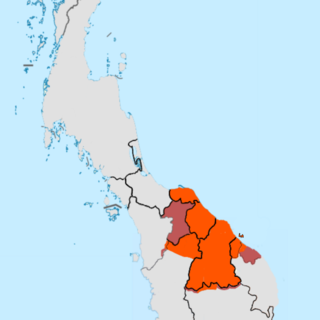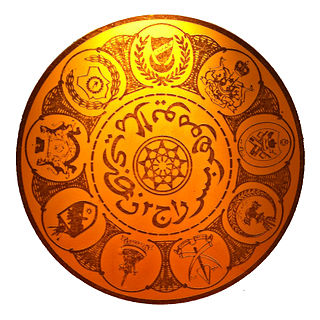
Kelantan is a state in Malaysia. The capital, Kota Bharu, includes the royal seat of Kubang Kerian. The honorific name of the state is Darul Naim. Kelantan is the only state outside of East Malaysia that does not use the term district in its second-level administrative division. Instead, the districts is named as colonies or collectivities and one autonomous subdistrict.

Kedah, also known by its honorific Darul Aman and historically as Queda, is a state of Malaysia, located in the northwestern part of Peninsular Malaysia. The state covers a total area of over 9,000 km2, and it consists of the mainland and the Langkawi islands. The mainland has a relatively flat terrain, which is used to grow rice, while Langkawi is an archipelago, most of which are uninhabited islands.

Terengganu, formerly spelled Trengganu or Tringganu, is a sultanate and federal state of Malaysia. The state is also known by its Arabic honorific, Dāru l-Īmān. The coastal city of Kuala Terengganu, which stands at the mouth of the broad Terengganu River, is both the state and royal capital as well as the most populous city in Terengganu. Other major cities and towns includes Jerteh, Kuala Dungun, Chukai, Kuala Berang, Marang, and Permaisuri. At 13,035 square kilometres in size and a population of over 1.2 million people in 2023, Terengganu is Malaysia's 7th largest state by area and 10th largest in population. Terengganu, along with Kelantan, Perlis and the Federal Territory of Putrajaya is one of the most homogeneous states/territories in the country of which 95% of the population are ethnic Malay-Muslims with its own distinct language/dialect, culture, history and tradition.

Kelantan-Pattani Malay is an Austronesian language of the Malayic subfamily spoken in the Malaysian state of Kelantan, as well as in Besut and Setiu districts of Terengganu state and the Perhentian Islands, and in the southernmost provinces of Thailand. It is the primary spoken language of Thai Malays, but is also used as a lingua franca by ethnic Southern Thais in rural areas, Muslim and non-Muslim and the Sam-Sam, a mostly Thai-speaking population of mixed Malay and Thai ancestry.

The term "British Malaya" loosely describes a set of states on the Malay Peninsula and the island of Singapore that were brought under British hegemony or control between the late 18th and the mid-20th century. Unlike the term "British India", which excludes the Indian princely states, British Malaya is often used to refer to the Federated and the Unfederated Malay States, which were British protectorates with their own local rulers, as well as the Straits Settlements, which were under the sovereignty and direct rule of the British Crown, after a period of control by the East India Company.

This article lists important figures and events in Malayan and Malaysian public affairs during the year 1963, together with births and deaths of significant Malaysians. The Federation of Malaya merged with Singapore, North Borneo, and Sarawak to form the Federation of Malaysia on 16 September.
This article lists important figures and events in Malayan public affairs during the year 1951, together with births and deaths of significant Malayans.

Malaysian Malays are Malaysians of Malay ethnicity whose ancestry originates wholly or partly in the Malay world. According to the 2023 population estimate, with a total population of 17.6 million, Malaysian Malays form 57.9% of Malaysia's demographics, the largest ethnic group in the country. They can be broadly classified into two main categories; Anak Jati and Anak Dagang.

Kedahan Malays or commonly known as Orang Utara ('Northerners'), are a sub-group of Malays native to northern Malay Peninsula in areas of both current and historical area of Kedah. They are among the oldest ethnic groups in the Malay peninsula with a history dating back 2,800 years as proven by the discovery of sites in Bujang Valley and historical documents from India, China and Arabia. Kedahan Malays are one of the largest Malay sub-groups in Malaysia, comprising at least 15% of the total Malaysian Malay population including those with Kedahan ancestry.

Peninsular Malaysia, historically known as Malaya, also known as West Malaysia or the "Malaysian Peninsula", is the western part of Malaysia that comprises the southern part of the Malay Peninsula on Mainland Southeast Asia and the nearby islands. Its area totals approximately 132,490 km2 (51,150 sq mi), which is nearly 40% of the total area of the country; the other 60% is in East Malaysia on the island of Borneo.

The monarchies of Malaysia exist in each of the nine Malay states under the constitutional monarchy system as practised in Malaysia. The political system of Malaysia is based on the Westminster parliamentary system in combination with features of a federation.
Liga Semi-Pro was a semi-pro football league in Malaysia that operated from 1989 until 1993. The league was managed by Football Association of Malaysia. It consist of two divisions, the Liga Semi-Pro Divisyen 1 and Liga Semi-Pro Divisyen 2. Liga Semi-Pro was official established in 1989 as a semi-pro league competition for football team in Malaysia to qualify for Piala Malaysia.
Liga Perdana 1 or Liga Perdana Satu was the nation's top-tier professional football league in Malaysia that operated from 1998 to 2003.
The Most Illustrious Royal Family Order of Kedah is the highest dynastic order of the House of Sri Mahawangsa and the second highest chivalric order of the state of Kedah ranking immediately after the State of Kedah Star of Valour. The order was constituted by Sultan Abdul Halim of Kedah on 21 February 1964.

Kelantanese Malays are a sub-ethnic group of Malays native to the state of Kelantan, Malaysia as well as in Northern Terengganu. The Kelantanese Malays are closely related to Thai Malays and Terengganuan Malays in neighbouring Terengganu, these two Malay sub-ethnic groups shared historical, cultural and linguistic as well as kinship ties with the Kelantanese Malays. Kelantanese Malays form 94% of Kelantan's population, which makes them the largest ethnic group in Kelantan and around 150,000 in Besut, Terengganu.
The orders, decorations, and medals of the Malaysian states and federal territories, in which each state and federal territory of Malaysia has devised a system of orders and awards to honour residents for actions or deeds that benefit their local community or state, are in turn subsumed within the Malaysian honours system. Each state sets their own rules and criteria on eligibility and also how each medal is awarded and presented. Most of the orders allow for the recipient to wear their orders in public, and most grant the recipients the use of post-nominal letters in their names.
Liga Malaysia was an amateur football league in Malaysia that operated from 1982 until 1988. The league was managed by the Football Association of Malaysia. The Malaysian League was established in 1982 after the introduction of a league trophy for the winner of the league stage qualification round for the Malaysia Cup, with the format first introduced in 1979 where the top eight teams qualified from the league to compete in the knockout stages of the Malaysia Cup.
This article lists important figures and events in the public affairs of British Malaya during the year 1909.
This article lists important figures and events in the public affairs of British Malaya during the year 1927, together with births and deaths of prominent Malayans.

The Minangkabau Malaysians are citizens of the Malaysia whose ancestral roots are from Minangkabau of central Sumatra. This includes people born in the Malaysia who are of Minangkabau origin as well as Minangkabau who have migrated to Malaysia. Today, Minangkabau comprise about 989,000 people in Malaysia, and Malaysian law considers most of them to be Malays. They are majority in urban areas, which has traditionally had the highest education and a strong entrepreneurial spirit. The history of the Minangkabau migration to Malay peninsula has been recorded to have lasted a very long time. When the means of transportation were still using the ships by down the rivers and crossing the strait, many Minang people migrated to various regions such as Negeri Sembilan, Malacca, Penang, Kedah, Perak, and Pahang. Some scholars noted that the arrival of the Minangkabau to the Malay Peninsula occurred in the 12th century. This ethnic group moved in to peninsula at the height of the Sultanate of Malacca, and maintains the Adat Perpatih of matrilineal kinships system in Negeri Sembilan and north Malacca.













